Advances and Developments within Mobile Technology
VerifiedAdded on 2023/05/26
|9
|2285
|310
AI Summary
This report discusses the evolution of mobile technology, current developments, data available for forensic investigators, and tools and methodologies for forensic analysis. The report concludes that while mobile technology has made life easier for users, it has also made devices vulnerable to cyber attacks, and digital forensic tools and methodologies are necessary to combat these attacks.
Contribute Materials
Your contribution can guide someone’s learning journey. Share your
documents today.
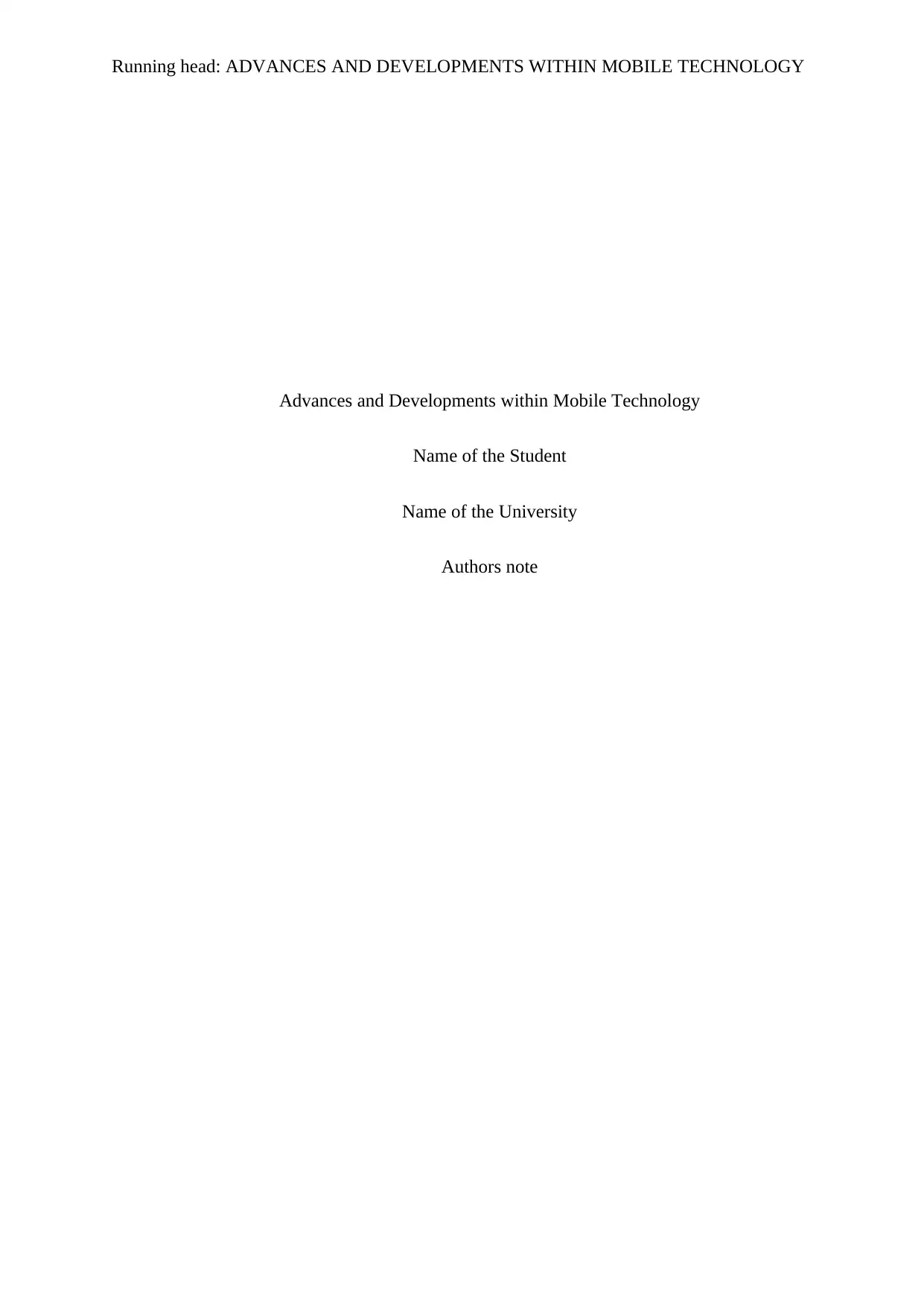
Running head: ADVANCES AND DEVELOPMENTS WITHIN MOBILE TECHNOLOGY
Advances and Developments within Mobile Technology
Name of the Student
Name of the University
Authors note
Advances and Developments within Mobile Technology
Name of the Student
Name of the University
Authors note
Secure Best Marks with AI Grader
Need help grading? Try our AI Grader for instant feedback on your assignments.
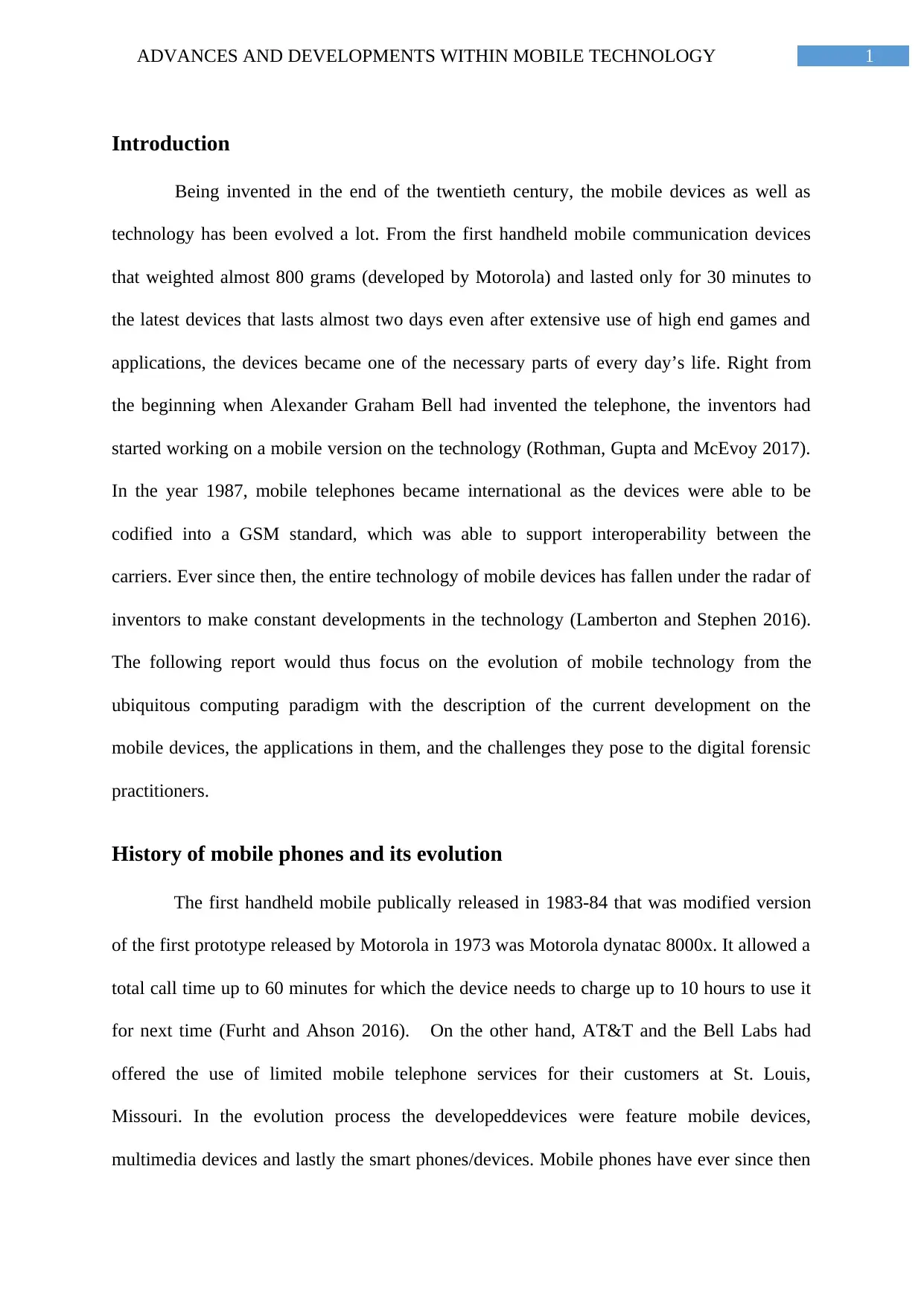
1ADVANCES AND DEVELOPMENTS WITHIN MOBILE TECHNOLOGY
Introduction
Being invented in the end of the twentieth century, the mobile devices as well as
technology has been evolved a lot. From the first handheld mobile communication devices
that weighted almost 800 grams (developed by Motorola) and lasted only for 30 minutes to
the latest devices that lasts almost two days even after extensive use of high end games and
applications, the devices became one of the necessary parts of every day’s life. Right from
the beginning when Alexander Graham Bell had invented the telephone, the inventors had
started working on a mobile version on the technology (Rothman, Gupta and McEvoy 2017).
In the year 1987, mobile telephones became international as the devices were able to be
codified into a GSM standard, which was able to support interoperability between the
carriers. Ever since then, the entire technology of mobile devices has fallen under the radar of
inventors to make constant developments in the technology (Lamberton and Stephen 2016).
The following report would thus focus on the evolution of mobile technology from the
ubiquitous computing paradigm with the description of the current development on the
mobile devices, the applications in them, and the challenges they pose to the digital forensic
practitioners.
History of mobile phones and its evolution
The first handheld mobile publically released in 1983-84 that was modified version
of the first prototype released by Motorola in 1973 was Motorola dynatac 8000x. It allowed a
total call time up to 60 minutes for which the device needs to charge up to 10 hours to use it
for next time (Furht and Ahson 2016). On the other hand, AT&T and the Bell Labs had
offered the use of limited mobile telephone services for their customers at St. Louis,
Missouri. In the evolution process the developeddevices were feature mobile devices,
multimedia devices and lastly the smart phones/devices. Mobile phones have ever since then
Introduction
Being invented in the end of the twentieth century, the mobile devices as well as
technology has been evolved a lot. From the first handheld mobile communication devices
that weighted almost 800 grams (developed by Motorola) and lasted only for 30 minutes to
the latest devices that lasts almost two days even after extensive use of high end games and
applications, the devices became one of the necessary parts of every day’s life. Right from
the beginning when Alexander Graham Bell had invented the telephone, the inventors had
started working on a mobile version on the technology (Rothman, Gupta and McEvoy 2017).
In the year 1987, mobile telephones became international as the devices were able to be
codified into a GSM standard, which was able to support interoperability between the
carriers. Ever since then, the entire technology of mobile devices has fallen under the radar of
inventors to make constant developments in the technology (Lamberton and Stephen 2016).
The following report would thus focus on the evolution of mobile technology from the
ubiquitous computing paradigm with the description of the current development on the
mobile devices, the applications in them, and the challenges they pose to the digital forensic
practitioners.
History of mobile phones and its evolution
The first handheld mobile publically released in 1983-84 that was modified version
of the first prototype released by Motorola in 1973 was Motorola dynatac 8000x. It allowed a
total call time up to 60 minutes for which the device needs to charge up to 10 hours to use it
for next time (Furht and Ahson 2016). On the other hand, AT&T and the Bell Labs had
offered the use of limited mobile telephone services for their customers at St. Louis,
Missouri. In the evolution process the developeddevices were feature mobile devices,
multimedia devices and lastly the smart phones/devices. Mobile phones have ever since then
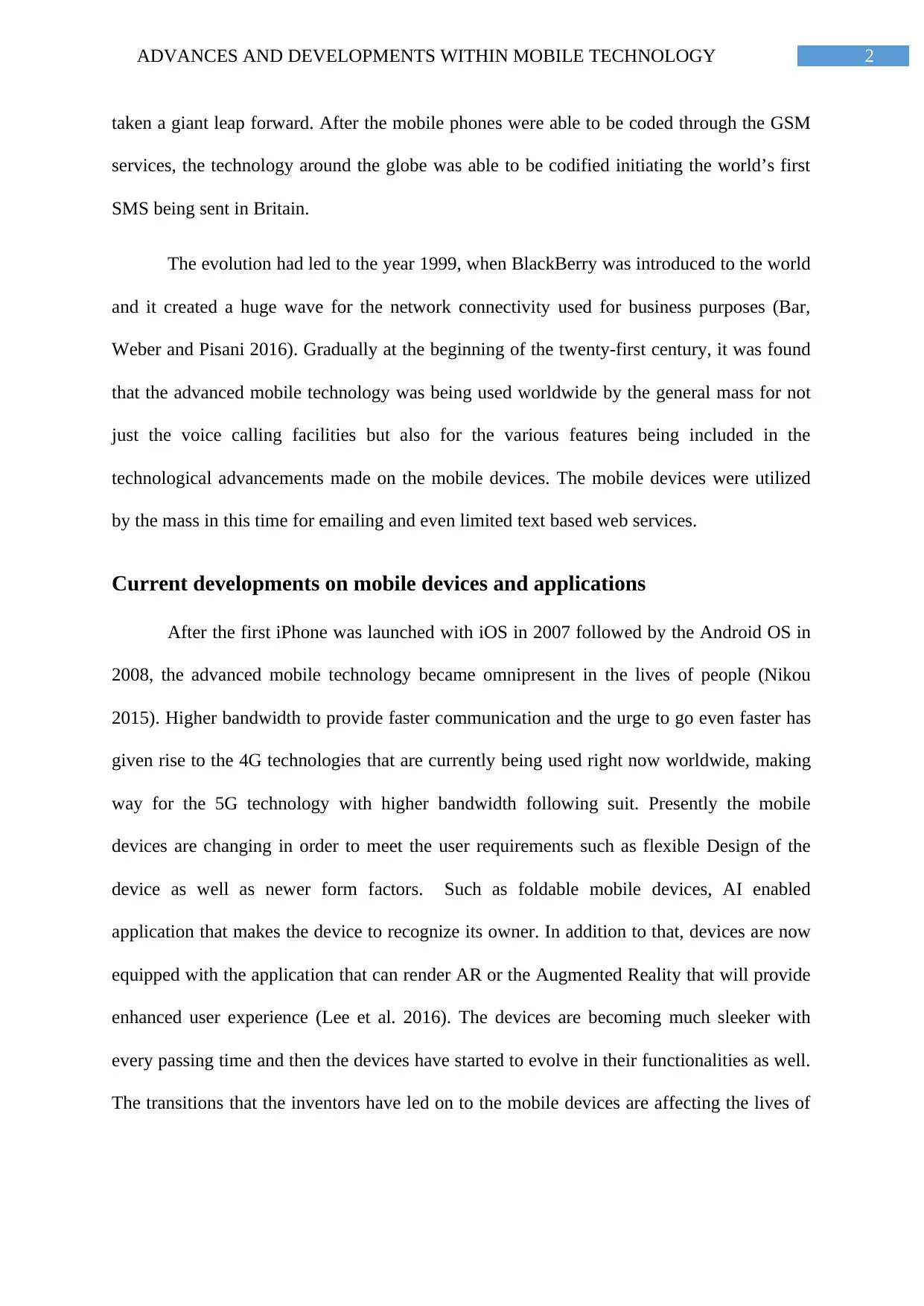
2ADVANCES AND DEVELOPMENTS WITHIN MOBILE TECHNOLOGY
taken a giant leap forward. After the mobile phones were able to be coded through the GSM
services, the technology around the globe was able to be codified initiating the world’s first
SMS being sent in Britain.
The evolution had led to the year 1999, when BlackBerry was introduced to the world
and it created a huge wave for the network connectivity used for business purposes (Bar,
Weber and Pisani 2016). Gradually at the beginning of the twenty-first century, it was found
that the advanced mobile technology was being used worldwide by the general mass for not
just the voice calling facilities but also for the various features being included in the
technological advancements made on the mobile devices. The mobile devices were utilized
by the mass in this time for emailing and even limited text based web services.
Current developments on mobile devices and applications
After the first iPhone was launched with iOS in 2007 followed by the Android OS in
2008, the advanced mobile technology became omnipresent in the lives of people (Nikou
2015). Higher bandwidth to provide faster communication and the urge to go even faster has
given rise to the 4G technologies that are currently being used right now worldwide, making
way for the 5G technology with higher bandwidth following suit. Presently the mobile
devices are changing in order to meet the user requirements such as flexible Design of the
device as well as newer form factors. Such as foldable mobile devices, AI enabled
application that makes the device to recognize its owner. In addition to that, devices are now
equipped with the application that can render AR or the Augmented Reality that will provide
enhanced user experience (Lee et al. 2016). The devices are becoming much sleeker with
every passing time and then the devices have started to evolve in their functionalities as well.
The transitions that the inventors have led on to the mobile devices are affecting the lives of
taken a giant leap forward. After the mobile phones were able to be coded through the GSM
services, the technology around the globe was able to be codified initiating the world’s first
SMS being sent in Britain.
The evolution had led to the year 1999, when BlackBerry was introduced to the world
and it created a huge wave for the network connectivity used for business purposes (Bar,
Weber and Pisani 2016). Gradually at the beginning of the twenty-first century, it was found
that the advanced mobile technology was being used worldwide by the general mass for not
just the voice calling facilities but also for the various features being included in the
technological advancements made on the mobile devices. The mobile devices were utilized
by the mass in this time for emailing and even limited text based web services.
Current developments on mobile devices and applications
After the first iPhone was launched with iOS in 2007 followed by the Android OS in
2008, the advanced mobile technology became omnipresent in the lives of people (Nikou
2015). Higher bandwidth to provide faster communication and the urge to go even faster has
given rise to the 4G technologies that are currently being used right now worldwide, making
way for the 5G technology with higher bandwidth following suit. Presently the mobile
devices are changing in order to meet the user requirements such as flexible Design of the
device as well as newer form factors. Such as foldable mobile devices, AI enabled
application that makes the device to recognize its owner. In addition to that, devices are now
equipped with the application that can render AR or the Augmented Reality that will provide
enhanced user experience (Lee et al. 2016). The devices are becoming much sleeker with
every passing time and then the devices have started to evolve in their functionalities as well.
The transitions that the inventors have led on to the mobile devices are affecting the lives of

3ADVANCES AND DEVELOPMENTS WITHIN MOBILE TECHNOLOGY
common people as well since human life is found to be transforming with every innovative
change brought about in the mobile technology.
Not just the implementation of the technology of virtual reality, but introduction of
Augmented Reality and Facial Recognition technology has made the mobile devices have
extremely enhanced features to make them as personal as possible to the users. The inventors
had made the android devices become even more durable while making the devices foldable.
This has enabled the devices to have enhanced battery life and even open to the technology of
wireless charging, which improves the battery lives even more (Loo, Mauri and Ortiz 2016).
The technology enhancements in the mobile devices have been ever evolving, with now the
virtual reality assistant available at summoning for the help of the users becoming the AI
companions. Further assistances are going on for enhancing the technologies even more, with
the sole purpose of making human lives more convenient through the use of mobile devices.
The mobile technology is right now heading towards the “Black Mirror” technology, where
the mobile technology would be directly implanted within the bodies of the users via chipsets
(Gozalvez 2016). Thus, it can easily be said that the future of mobile technology is getting
closer to the augmented reality reveries that had so far been only imagined in science-fiction
ventures.
Data available within a mobile phone for forensic investigators
Nowadays, mobile phones have become an integral part in the daily lives of the
common human beings. However, with increased technological enhancements, they have
become vulnerable to becoming victims to cyber criminal activities or otherwise becoming
the tools to facilitate these activities. The reason for this can be speculated to be the way by
which a mobile device is increasingly becoming personal to its user. No other computing
device is being as personal as these devices, more effectively, being the computers available
common people as well since human life is found to be transforming with every innovative
change brought about in the mobile technology.
Not just the implementation of the technology of virtual reality, but introduction of
Augmented Reality and Facial Recognition technology has made the mobile devices have
extremely enhanced features to make them as personal as possible to the users. The inventors
had made the android devices become even more durable while making the devices foldable.
This has enabled the devices to have enhanced battery life and even open to the technology of
wireless charging, which improves the battery lives even more (Loo, Mauri and Ortiz 2016).
The technology enhancements in the mobile devices have been ever evolving, with now the
virtual reality assistant available at summoning for the help of the users becoming the AI
companions. Further assistances are going on for enhancing the technologies even more, with
the sole purpose of making human lives more convenient through the use of mobile devices.
The mobile technology is right now heading towards the “Black Mirror” technology, where
the mobile technology would be directly implanted within the bodies of the users via chipsets
(Gozalvez 2016). Thus, it can easily be said that the future of mobile technology is getting
closer to the augmented reality reveries that had so far been only imagined in science-fiction
ventures.
Data available within a mobile phone for forensic investigators
Nowadays, mobile phones have become an integral part in the daily lives of the
common human beings. However, with increased technological enhancements, they have
become vulnerable to becoming victims to cyber criminal activities or otherwise becoming
the tools to facilitate these activities. The reason for this can be speculated to be the way by
which a mobile device is increasingly becoming personal to its user. No other computing
device is being as personal as these devices, more effectively, being the computers available
Secure Best Marks with AI Grader
Need help grading? Try our AI Grader for instant feedback on your assignments.
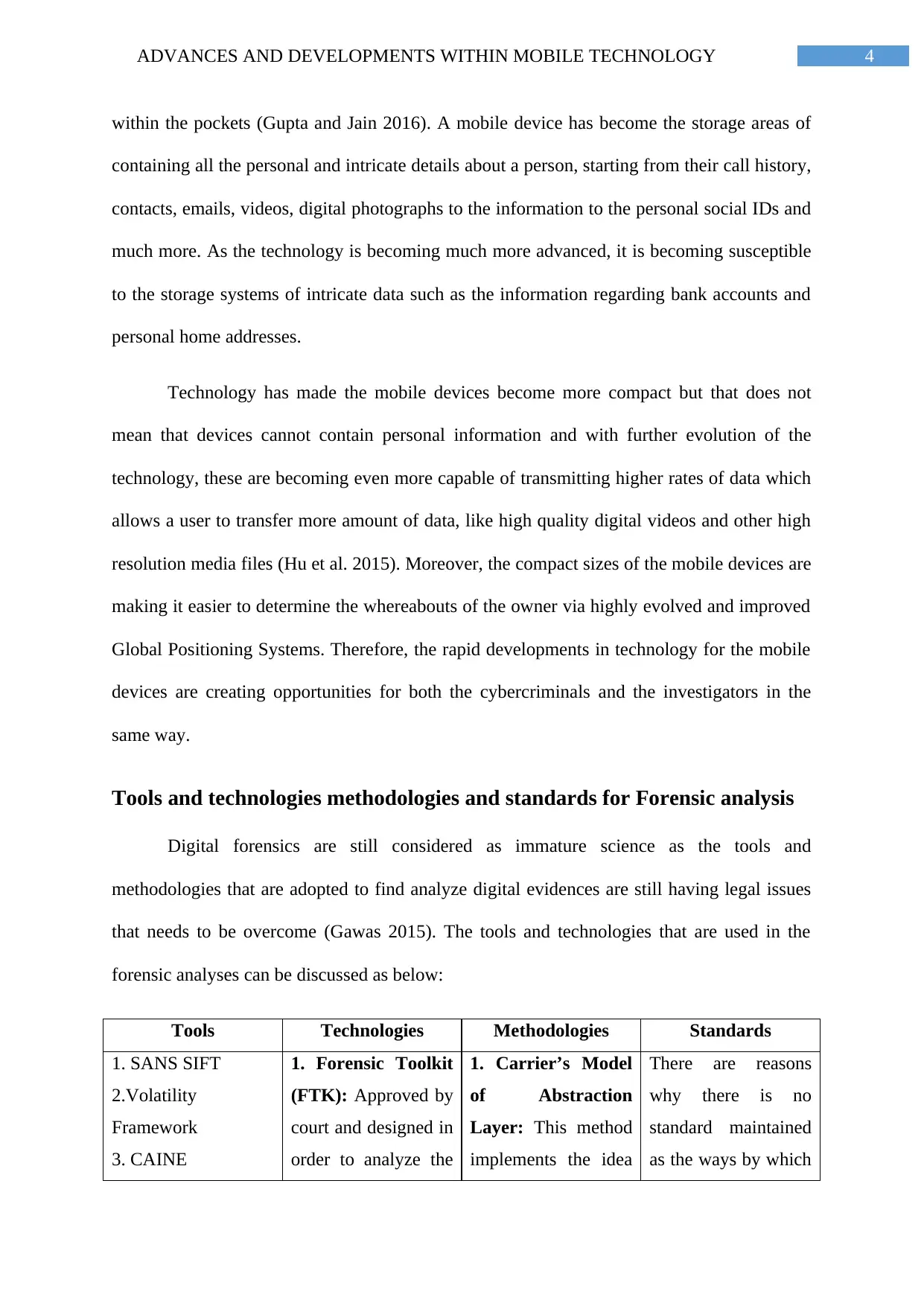
4ADVANCES AND DEVELOPMENTS WITHIN MOBILE TECHNOLOGY
within the pockets (Gupta and Jain 2016). A mobile device has become the storage areas of
containing all the personal and intricate details about a person, starting from their call history,
contacts, emails, videos, digital photographs to the information to the personal social IDs and
much more. As the technology is becoming much more advanced, it is becoming susceptible
to the storage systems of intricate data such as the information regarding bank accounts and
personal home addresses.
Technology has made the mobile devices become more compact but that does not
mean that devices cannot contain personal information and with further evolution of the
technology, these are becoming even more capable of transmitting higher rates of data which
allows a user to transfer more amount of data, like high quality digital videos and other high
resolution media files (Hu et al. 2015). Moreover, the compact sizes of the mobile devices are
making it easier to determine the whereabouts of the owner via highly evolved and improved
Global Positioning Systems. Therefore, the rapid developments in technology for the mobile
devices are creating opportunities for both the cybercriminals and the investigators in the
same way.
Tools and technologies methodologies and standards for Forensic analysis
Digital forensics are still considered as immature science as the tools and
methodologies that are adopted to find analyze digital evidences are still having legal issues
that needs to be overcome (Gawas 2015). The tools and technologies that are used in the
forensic analyses can be discussed as below:
Tools Technologies Methodologies Standards
1. SANS SIFT
2.Volatility
Framework
3. CAINE
1. Forensic Toolkit
(FTK): Approved by
court and designed in
order to analyze the
1. Carrier’s Model
of Abstraction
Layer: This method
implements the idea
There are reasons
why there is no
standard maintained
as the ways by which
within the pockets (Gupta and Jain 2016). A mobile device has become the storage areas of
containing all the personal and intricate details about a person, starting from their call history,
contacts, emails, videos, digital photographs to the information to the personal social IDs and
much more. As the technology is becoming much more advanced, it is becoming susceptible
to the storage systems of intricate data such as the information regarding bank accounts and
personal home addresses.
Technology has made the mobile devices become more compact but that does not
mean that devices cannot contain personal information and with further evolution of the
technology, these are becoming even more capable of transmitting higher rates of data which
allows a user to transfer more amount of data, like high quality digital videos and other high
resolution media files (Hu et al. 2015). Moreover, the compact sizes of the mobile devices are
making it easier to determine the whereabouts of the owner via highly evolved and improved
Global Positioning Systems. Therefore, the rapid developments in technology for the mobile
devices are creating opportunities for both the cybercriminals and the investigators in the
same way.
Tools and technologies methodologies and standards for Forensic analysis
Digital forensics are still considered as immature science as the tools and
methodologies that are adopted to find analyze digital evidences are still having legal issues
that needs to be overcome (Gawas 2015). The tools and technologies that are used in the
forensic analyses can be discussed as below:
Tools Technologies Methodologies Standards
1. SANS SIFT
2.Volatility
Framework
3. CAINE
1. Forensic Toolkit
(FTK): Approved by
court and designed in
order to analyze the
1. Carrier’s Model
of Abstraction
Layer: This method
implements the idea
There are reasons
why there is no
standard maintained
as the ways by which
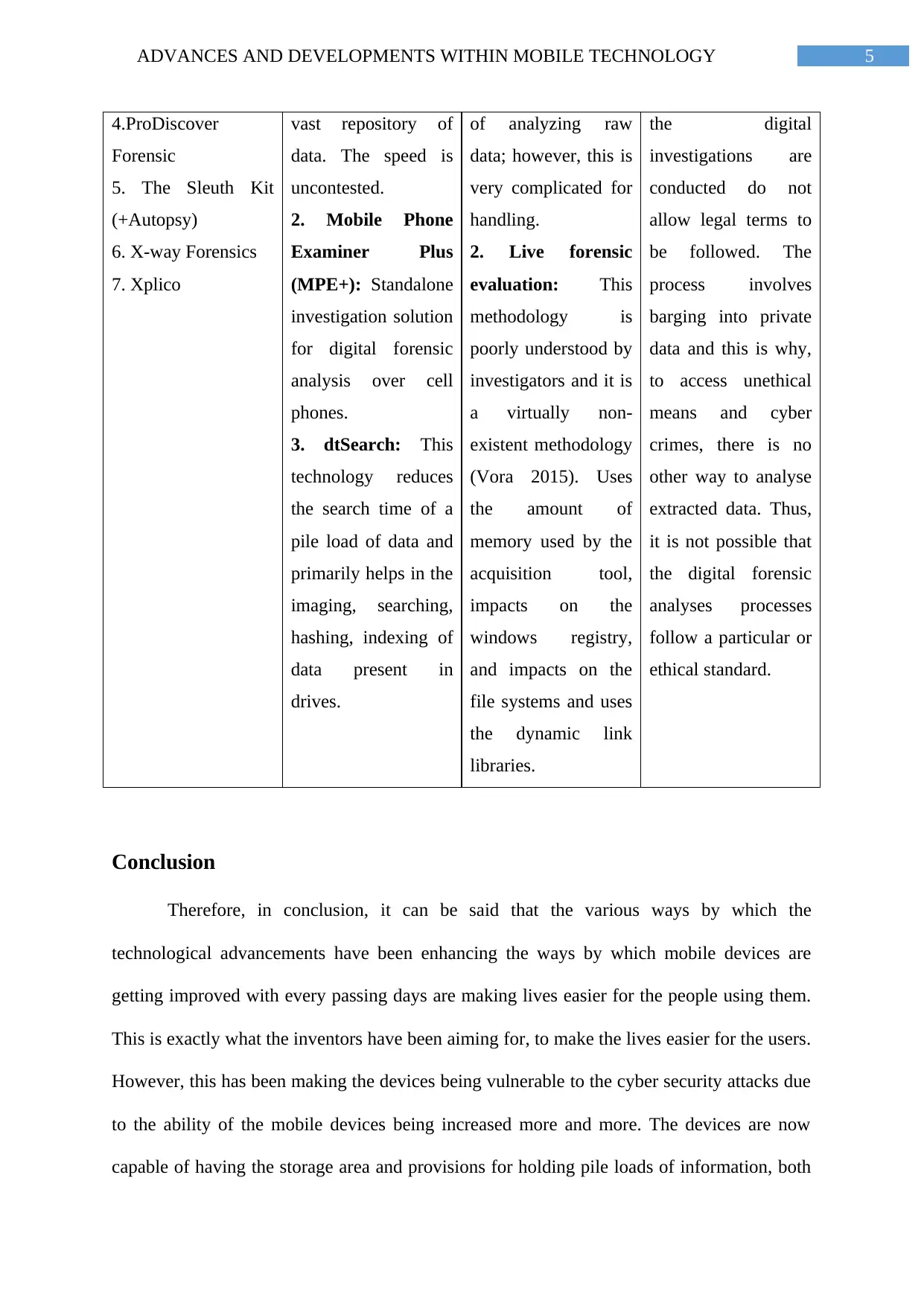
5ADVANCES AND DEVELOPMENTS WITHIN MOBILE TECHNOLOGY
4.ProDiscover
Forensic
5. The Sleuth Kit
(+Autopsy)
6. X-way Forensics
7. Xplico
vast repository of
data. The speed is
uncontested.
2. Mobile Phone
Examiner Plus
(MPE+): Standalone
investigation solution
for digital forensic
analysis over cell
phones.
3. dtSearch: This
technology reduces
the search time of a
pile load of data and
primarily helps in the
imaging, searching,
hashing, indexing of
data present in
drives.
of analyzing raw
data; however, this is
very complicated for
handling.
2. Live forensic
evaluation: This
methodology is
poorly understood by
investigators and it is
a virtually non-
existent methodology
(Vora 2015). Uses
the amount of
memory used by the
acquisition tool,
impacts on the
windows registry,
and impacts on the
file systems and uses
the dynamic link
libraries.
the digital
investigations are
conducted do not
allow legal terms to
be followed. The
process involves
barging into private
data and this is why,
to access unethical
means and cyber
crimes, there is no
other way to analyse
extracted data. Thus,
it is not possible that
the digital forensic
analyses processes
follow a particular or
ethical standard.
Conclusion
Therefore, in conclusion, it can be said that the various ways by which the
technological advancements have been enhancing the ways by which mobile devices are
getting improved with every passing days are making lives easier for the people using them.
This is exactly what the inventors have been aiming for, to make the lives easier for the users.
However, this has been making the devices being vulnerable to the cyber security attacks due
to the ability of the mobile devices being increased more and more. The devices are now
capable of having the storage area and provisions for holding pile loads of information, both
4.ProDiscover
Forensic
5. The Sleuth Kit
(+Autopsy)
6. X-way Forensics
7. Xplico
vast repository of
data. The speed is
uncontested.
2. Mobile Phone
Examiner Plus
(MPE+): Standalone
investigation solution
for digital forensic
analysis over cell
phones.
3. dtSearch: This
technology reduces
the search time of a
pile load of data and
primarily helps in the
imaging, searching,
hashing, indexing of
data present in
drives.
of analyzing raw
data; however, this is
very complicated for
handling.
2. Live forensic
evaluation: This
methodology is
poorly understood by
investigators and it is
a virtually non-
existent methodology
(Vora 2015). Uses
the amount of
memory used by the
acquisition tool,
impacts on the
windows registry,
and impacts on the
file systems and uses
the dynamic link
libraries.
the digital
investigations are
conducted do not
allow legal terms to
be followed. The
process involves
barging into private
data and this is why,
to access unethical
means and cyber
crimes, there is no
other way to analyse
extracted data. Thus,
it is not possible that
the digital forensic
analyses processes
follow a particular or
ethical standard.
Conclusion
Therefore, in conclusion, it can be said that the various ways by which the
technological advancements have been enhancing the ways by which mobile devices are
getting improved with every passing days are making lives easier for the people using them.
This is exactly what the inventors have been aiming for, to make the lives easier for the users.
However, this has been making the devices being vulnerable to the cyber security attacks due
to the ability of the mobile devices being increased more and more. The devices are now
capable of having the storage area and provisions for holding pile loads of information, both

6ADVANCES AND DEVELOPMENTS WITHIN MOBILE TECHNOLOGY
confidential and intricate, about the person using them. Nevertheless, this also creates the
provision for the Digital Investigators to get hold of these malicious cyber criminals through
the same advanced technology and through various Digital Forensic tools and methodologies
utilized.
confidential and intricate, about the person using them. Nevertheless, this also creates the
provision for the Digital Investigators to get hold of these malicious cyber criminals through
the same advanced technology and through various Digital Forensic tools and methodologies
utilized.
Paraphrase This Document
Need a fresh take? Get an instant paraphrase of this document with our AI Paraphraser
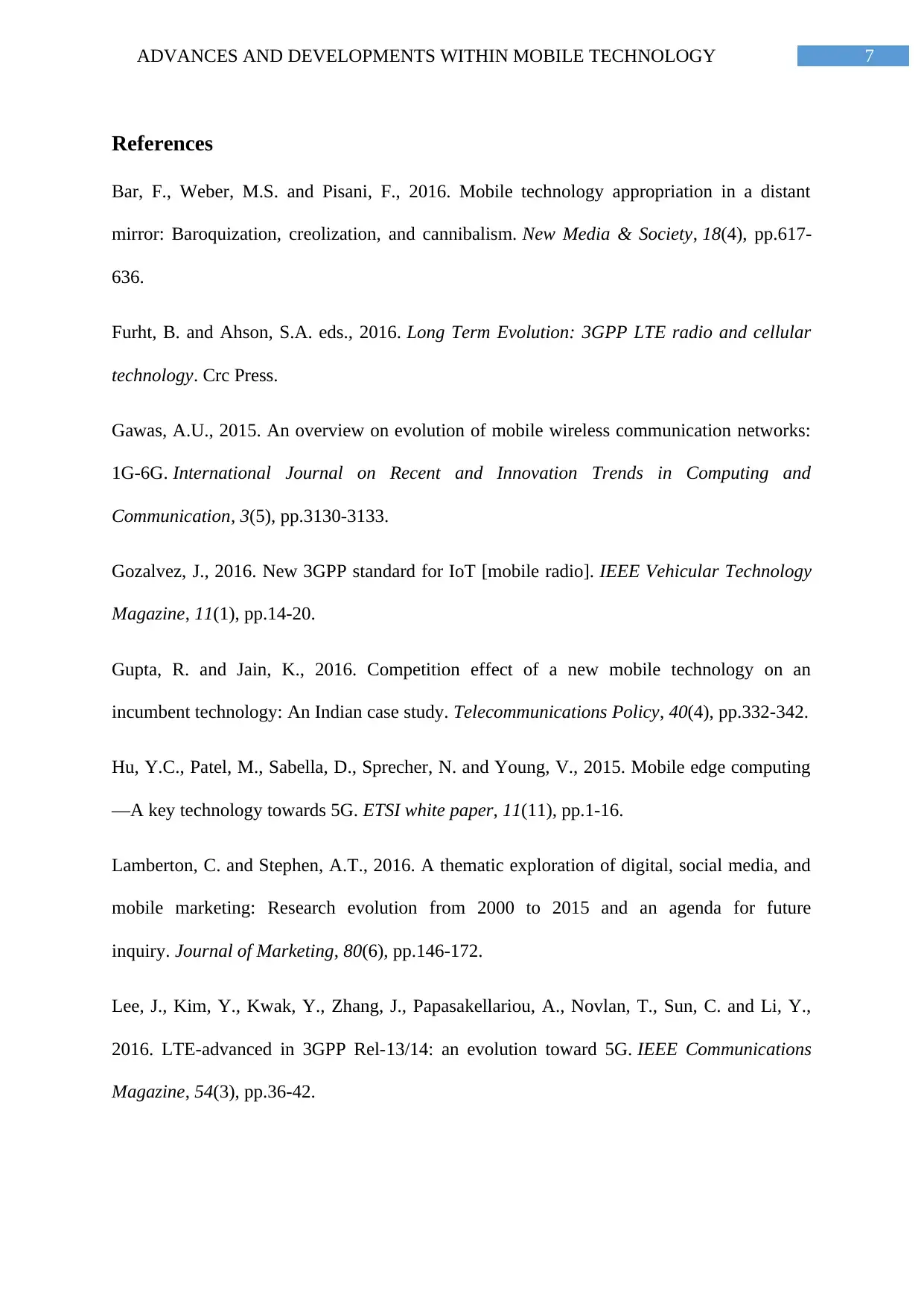
7ADVANCES AND DEVELOPMENTS WITHIN MOBILE TECHNOLOGY
References
Bar, F., Weber, M.S. and Pisani, F., 2016. Mobile technology appropriation in a distant
mirror: Baroquization, creolization, and cannibalism. New Media & Society, 18(4), pp.617-
636.
Furht, B. and Ahson, S.A. eds., 2016. Long Term Evolution: 3GPP LTE radio and cellular
technology. Crc Press.
Gawas, A.U., 2015. An overview on evolution of mobile wireless communication networks:
1G-6G. International Journal on Recent and Innovation Trends in Computing and
Communication, 3(5), pp.3130-3133.
Gozalvez, J., 2016. New 3GPP standard for IoT [mobile radio]. IEEE Vehicular Technology
Magazine, 11(1), pp.14-20.
Gupta, R. and Jain, K., 2016. Competition effect of a new mobile technology on an
incumbent technology: An Indian case study. Telecommunications Policy, 40(4), pp.332-342.
Hu, Y.C., Patel, M., Sabella, D., Sprecher, N. and Young, V., 2015. Mobile edge computing
—A key technology towards 5G. ETSI white paper, 11(11), pp.1-16.
Lamberton, C. and Stephen, A.T., 2016. A thematic exploration of digital, social media, and
mobile marketing: Research evolution from 2000 to 2015 and an agenda for future
inquiry. Journal of Marketing, 80(6), pp.146-172.
Lee, J., Kim, Y., Kwak, Y., Zhang, J., Papasakellariou, A., Novlan, T., Sun, C. and Li, Y.,
2016. LTE-advanced in 3GPP Rel-13/14: an evolution toward 5G. IEEE Communications
Magazine, 54(3), pp.36-42.
References
Bar, F., Weber, M.S. and Pisani, F., 2016. Mobile technology appropriation in a distant
mirror: Baroquization, creolization, and cannibalism. New Media & Society, 18(4), pp.617-
636.
Furht, B. and Ahson, S.A. eds., 2016. Long Term Evolution: 3GPP LTE radio and cellular
technology. Crc Press.
Gawas, A.U., 2015. An overview on evolution of mobile wireless communication networks:
1G-6G. International Journal on Recent and Innovation Trends in Computing and
Communication, 3(5), pp.3130-3133.
Gozalvez, J., 2016. New 3GPP standard for IoT [mobile radio]. IEEE Vehicular Technology
Magazine, 11(1), pp.14-20.
Gupta, R. and Jain, K., 2016. Competition effect of a new mobile technology on an
incumbent technology: An Indian case study. Telecommunications Policy, 40(4), pp.332-342.
Hu, Y.C., Patel, M., Sabella, D., Sprecher, N. and Young, V., 2015. Mobile edge computing
—A key technology towards 5G. ETSI white paper, 11(11), pp.1-16.
Lamberton, C. and Stephen, A.T., 2016. A thematic exploration of digital, social media, and
mobile marketing: Research evolution from 2000 to 2015 and an agenda for future
inquiry. Journal of Marketing, 80(6), pp.146-172.
Lee, J., Kim, Y., Kwak, Y., Zhang, J., Papasakellariou, A., Novlan, T., Sun, C. and Li, Y.,
2016. LTE-advanced in 3GPP Rel-13/14: an evolution toward 5G. IEEE Communications
Magazine, 54(3), pp.36-42.

8ADVANCES AND DEVELOPMENTS WITHIN MOBILE TECHNOLOGY
Loo, J., Mauri, J.L. and Ortiz, J.H. eds., 2016. Mobile ad hoc networks: current status and
future trends. CRC Press.
Nikou, S., 2015. Mobile technology and forgotten consumers: the young‐
elderly. International Journal of Consumer Studies, 39(4), pp.294-304.
Rothman, B.S., Gupta, R.K. and McEvoy, M.D., 2017. Mobile technology in the
perioperative arena: rapid evolution and future disruption. Anesthesia & Analgesia, 124(3),
pp.807-818.
Vora, L.J., 2015. Evolution of mobile generation technology: 1G to 5G and review of
upcoming wireless technology 5G. International Journal of Modern Trends in Engineering
and Research, 2(10), pp.281-290.
Loo, J., Mauri, J.L. and Ortiz, J.H. eds., 2016. Mobile ad hoc networks: current status and
future trends. CRC Press.
Nikou, S., 2015. Mobile technology and forgotten consumers: the young‐
elderly. International Journal of Consumer Studies, 39(4), pp.294-304.
Rothman, B.S., Gupta, R.K. and McEvoy, M.D., 2017. Mobile technology in the
perioperative arena: rapid evolution and future disruption. Anesthesia & Analgesia, 124(3),
pp.807-818.
Vora, L.J., 2015. Evolution of mobile generation technology: 1G to 5G and review of
upcoming wireless technology 5G. International Journal of Modern Trends in Engineering
and Research, 2(10), pp.281-290.
1 out of 9
Related Documents
Your All-in-One AI-Powered Toolkit for Academic Success.
+13062052269
info@desklib.com
Available 24*7 on WhatsApp / Email
![[object Object]](/_next/static/media/star-bottom.7253800d.svg)
Unlock your academic potential
© 2024 | Zucol Services PVT LTD | All rights reserved.





